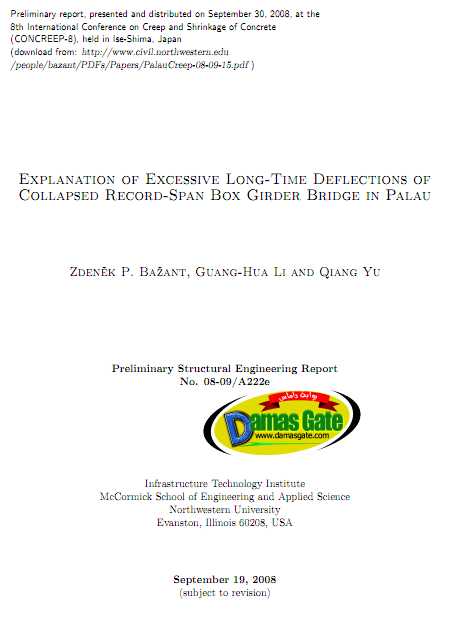Elplanation of Excessive Long Time Deflections of Collapsed Record Span Box Girder Bridges

Explanation of Excessive Long-Time De°ections of
Collapsed Record-Span Box Girder Bridge in Palau
Abstract: Explanation of the excessive de°ections of the Koror-Babeldaob (KB) Bridge in Palau
is presented. This bridge was built in 1977 by the cantilever method and collapsed 3 months after
remedial prestressing in 1996. It was a segmental prestressed concrete girder having the worldrecord
span of 241 m (790 ft.) and maximum girder depth of 14.17 m (46.5 ft). The ¯nal mid-span
de°ection was in design expected to be 0.53 to 0.65 m (20.7 to 25.5 in), but after 18 years it
reached 1.39 m (54.6 in.) and was still growing. Presented is an accurate analysis using 5906
three-dimensional (3D) ¯nite elements and step-by-step integration in time. For the concrete creep
and shrinkage properties, the B3, GL, ACI and CEB (or CEB-FIP, ¯b) models are considered and
predictions compared. Model B3, in contrast to the others, does not give an unambiguous prediction
because, in addition to concrete design strength, it necessitates further input parameters which are
unknown. These are three mix parameters which can be set to default values but can also be varied
over a realistic range to ascertain the range of realistic predictions. The ¯ndings are as follows: 1) For
model B3, one can ¯nd plausible values of input parameters for which all the measured de°ections
(as well as Troxell et al.'s 23-year creep tests) can be closely matched, while for the other models
they cannot even be approached and the observed shape of creep curve cannot be reproduced. 2)
The 18-year de°ections calculated by 3D ¯nite elements according the ACI, CEB and GL models
are about 66%, 63% and 40% less, respectively, than those measured and calculated according to
model B3, and their de°ection curves have shapes rather di®erent from the those measured. 3)
The shear lag is important since it increases the downward de°ection due to self-weight much more
than the upward de°ection due to prestress. 4) The de°ection is highly sensitive to prestress loss
because it represents a small di®erence of two large numbers (de°ections due to self-weight, and to
prestress). According to the ACI, CEB and GL models, the prestress loss obtained by the same ¯nite
element code is, respectively, about 56%, 46% and 37% smaller, and according to the classical lump
estimate used in design about 54% smaller. 5) Model B3 is in agreement with the measurements
if 3D ¯nite elements with step-by-step time integration are used to calculate both the de°ections
and the prestress losses, and if the di®erences in shrinkage and drying creep properties caused
by di®erences in slab thickness and temperature are taken into account.
Download
*